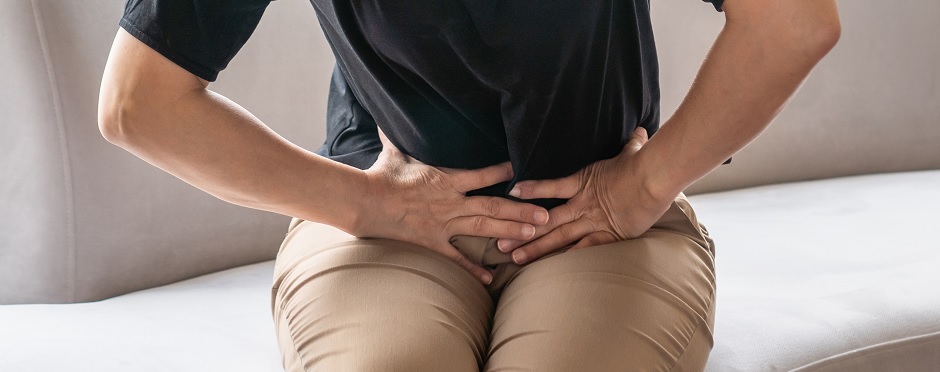
How Much Is Too Much? What You Need to Know About Urinary Frequency
2 CommentsHow much is too much? This is the question hidden in my patients’ jokes about having “the smallest bladder on earth” or comments that they wake up frequently at night “but that’s just part of aging.” These patients often feel like their bladder runs the show and they have little to no control over how often they go to the bathroom. It interferes with sleep, work, exercise, and even social activities.
What is normal?
In general, you should be able to wait about 3 – 4 hours between trips to the bathroom.1 In other words, you should be able to watch a full movie without needing to get up. This usually means folks are urinating about four- seven times per day. You should also be able to sleep through the night. Waking up at night to urinate, also known as Nocturia, disrupts sleep, and people who wake up more than two times each night are more likely to report that this is bothersome.1
Why does it matter?
It is estimated that 34 million people in the United States struggle with overactive bladder or increased urinary frequency.2 Nocturia is known to disrupt sleep which interferes with focus, work productivity, and overall quality of life.3,4 Older adults, who often have issues with balance and night vision as well, are more likely to fall and injure themselves if they have nocturia.5,6
The estimated cost of elevated urinary frequency in the United States ranges between $61 and $66 billion.2,7 These figures include direct costs, like medicine and injuries associated with falls, as well as indirect costs, such as reduced work productivity caused by overactive bladder.
How can physical therapy help?
Pelvic floor physical therapy is a safe, conservative treatment that is effective in reducing reliance on medications or surgical interventions.8,9 In fact, physical therapy was found to be more effective than bladder-relaxant medication in reducing nocturia.10 Pelvic floor physical therapy consists of a variety of different techniques but might include:
- Pelvic floor muscle assessment and strengthening or relaxation of these muscles
- Urge reduction techniques
- Tibial nerve stimulation
- Timed voiding
As physical therapists, we may also address other musculoskeletal complaints contributing to increased urgency such as:
- Poor balance
- Hip/Low back/Pubic pain
- Difficulty walking or getting out of a chair
At Athletico, our pelvic floor physical therapists specialize in the treatment of many bowel and bladder-related issues. To see if pelvic floor physical therapy is right for you, take our bladder quiz or fill out this bladder log. To get started, request a Free Assessment with an Athletico clinician. Free Assessments are available both in-clinic and virtually through our Telehealth service.
The Athletico blog is an educational resource written by Athletico employees. Athletico bloggers are licensed professionals who abide by the code of ethics outlined by their respective professional associations. The content published in blog posts represents the opinion of the individual author based on their expertise and experience. The content provided in this blog is for informational purposes only, does not constitute medical advice and should not be relied on for making personal health decisions.
Works Cited:
1. Lukacz ES, Whitcomb EL, Lawrence JM, Nager CW, Luber KM. Urinary frequency in community-dwelling women: what is normal? Am J Obstet Gynecol. 2009;200(5):552.e1-552.e7. doi:https://doi.org/10.1016/j.ajog.2008.11.006
2. Ganz ML, Smalarz AM, Krupski TL, et al. Economic Costs of Overactive Bladder in the United States. Urology. 2010;75(3):526-532.e18. doi:10.1016/j.urology.2009.06.096
3. Bliwise DL, Foley DJ, Vitiello MV, Ansari FP, Ancoli-Israel S, Walsh JK. Nocturia and disturbed sleep in the elderly. Sleep Med. 2009;10(5):540-548. doi:10.1016/j.sleep.2008.04.002
4. Ancoli-Israel S, Bliwise DL, Nørgaard JP. The effect of nocturia on sleep. Sleep Med Rev. 2011;15(2):91-97. doi:10.1016/j.smrv.2010.03.002
5. Galizia G, Langellotto A, Cacciatore F, et al. Association Between Nocturia and Falls-Related Long-Term Mortality Risk in the Elderly. J Am Med Dir Assoc. 2012;13(7):640-644. doi:10.1016/j.jamda.2012.05.016
6. Vaughan CP, Brown CJ, Goode PS, Burgio KL, Allman RM, Johnson I TM. The association of nocturia with incident falls in an elderly community-dwelling cohort. Int J Clin Pract. 2010;64(5):577-583. doi:10.1111/j.1742-1241.2009.02326
7. Holm-Larsen T. The economic impact of nocturia. Neurourol Urodyn. 2014;33(S1):S10-S14. doi:10.1002/nau.22593
8. Adams SR, Dessie SG, Dodge LE, Mckinney JL, Hacker MR, Elkadry EA. Pelvic Floor Physical Therapy as Primary Treatment of Pelvic Floor Disorders With Urinary Urgency and Frequency-Predominant Symptoms. Female Pelvic Med Reconstr Surg. 2015;21(5). https://journals.lww.com/fpmrs/Fulltext/2015/09000/Pelvic_Floor_Physical_Therapy_as_Primary_Treatment.4.aspx
9. Burgio KL. Update on Behavioral and Physical Therapies for Incontinence and Overactive Bladder: The Role of Pelvic Floor Muscle Training. Curr Urol Rep. 2013;14(5):457-464. doi:10.1007/s11934-013-0358-1
10. Johnson 2nd TM, Markland AD, Goode PS, et al. Efficacy of adding behavioural treatment or antimuscarinic drug therapy to α-blocker therapy in men with nocturia. BJU Int. 2013;112(1):100-108. doi:10.1111/j.1464-410X.2012.11736.

2 Comments
Joan Small
Since I have fell I can’t walk r raise my arms I can’t get off bed it out keeps getting worse will it ever get better I can’t go store do my house work had x-rays they said nothing is btoke what do I do pain going all over my body please help me
Dr.VVSS Chandrasekharam
pelvic therapies are good to control urinary frequency but before that focusing on diet, lifestyle, physical activities also important to control it